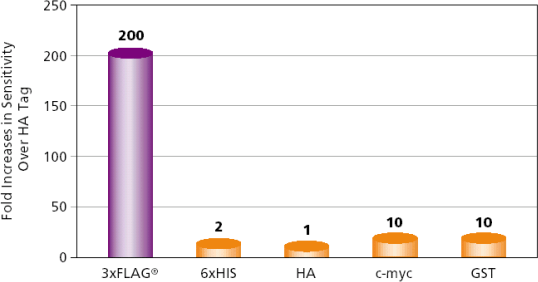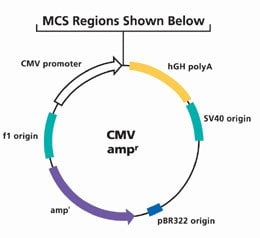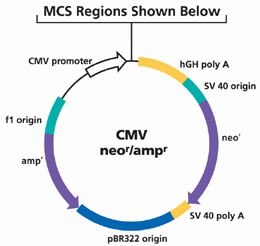3xFLAG® System Expression Vectors for Ultra-Sensitive Detection of Recombinant Proteins
The 3xFLAG® system is an improvement upon the original system by fusing three tandem FLAG® epitopes for a total of 22 amino acids (Figure 1). Detection of fusion proteins containing 3xFLAG® is enhanced up to 200 times more than any other system. Like the original FLAG tag, 3xFLAG® is hydrophilic, contains an Enterokinase cleavage site, and is relatively small. Therefore, the risk of altering protein function, blocking other epitopes, or decreasing solubility is minimized. In cases of low-level expression, 3xFLAG® is ideal. Our selection of CMV vectors provides options for transient or stable expression of 3xFLAG® fusion proteins.
- Ultrasensitive System - Detect < 10 femtomoles using ANTI-FLAG® Antibodies (Figure 2); Ideal for cases of low-level expression in mammalian cells.
- Superior Detection - 20-200x more sensitive than any other system (Figure 3).
- Versatile - Enhanced detection for immunoprecipitation, Western blots and immunocytochemistry.
- Wide Selection of Detection and Purification Products - ANTI-FLAG antibodies, resins, and affinity capture plates.

Figure 1.3xFLAG® Sequence. Removal of N-terminal 3xFLAG® tags is possible using enterokinase, which cleaves following the Asp-Asp-Asp-Asp-Lys amino acid sequence at the c-terminal end of the tag

Figure 2.Western Blot of Original FLAG Versus 3xFLAG®. Western blot of purified 3xFLAG®-BAP (bacterial alkaline phosphatase) and FLAG®-BAP transferred onto a nitrocellulose membrane. Detection was performed with ANTI-FLAG® M2 monoclonal primary antibody, anti-mouse-HRP secondary antibody, and ECL™ chemiluminescent substrate.

Figure 3.Comparative Sensitivity of 3xFLAG®. Each protein fusion tag was cloned separately on the C terminal of GST. The purified proteins were diluted from 1 ug to 0.01 ng and analyzed. The limit of detection of each tag was determined by Western blot analysis using the recommended dilutions of each respective primary antibody and secondary anti-mouse IgG-HRP conjugate. The blot was developed using ECL.
CMV Vector Features
Our mammalian expression vectors contain the strong CMV promoter for high-level constitutive expression in mammalian cells. The strong human cytomegalovirus (CMV) promoter regulatory region drives constitutive protein expression levels as high as 1 mG/L in COS cells. For less potent cell lines, protein levels are typically ~0.1 mG/L. The presence of the SV40 replication origin will result in high levels of DNA replication in SV40 replication permissive COS cells. Vectors containing the preprotrypsin leader (PPT) sequence direct secretion of FLAG fusion proteins into the culture medium for purification using ANTI-FLAG antibodies, resins, and plates.
Transient Expression Vectors
- N-terminal fusions
- Cytoplasmic expression
- PPT leader sequence for secretion
- Dual tag configurations
- Enterokinase removal of 3xFLAG® tags
- pMB1 (derivative of pBR322) origin for replication in bacterial cells
- β-lactamase gene for ampicillin resistance selection in bacteria

Figure 4.MCS Regions
Stable Expression Vectors
- Stable expression with neomycin selection (G 418 sulfate)
- N- or C- terminal fusions
- Dual tag configurations
- Cytoplasmic expression or secretion
- Enterokinase removal of N-terminal 3xFLAG® tags
- pMB1 (derivative of pBR322) origin for replication in bacterial cells
- β-lactamase gene for ampicillin resistance selection in bacteria

Figure 5.Stable Expression Vector
BICEP™ Stable Expression Vectors
- Superior stable expression
- Neor gene is translated in a cap-independent fashion under control of the EMCV IRES
- Stable cell line production without concern of plasmid loss
- Expression levels outperform competition >30-fold
- Maintains high expression levels after numerous passages

Figure 6.Bicep Stable Expression Vector
To continue reading please sign in or create an account.
Don't Have An Account?